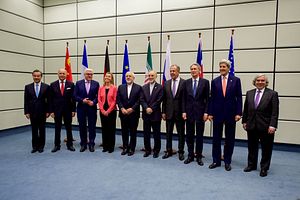Iran and the P5+1—a group including the United States, Russia, China, France, the United Kingdom, and Germany—have reached a final agreement, a Joint Comprehensive Plan of Action (JCPOA) over Iran’s nuclear program. The agreement comes nearly 20 months after the November 2013 Joint Plan of Action, in which Iran made major technical concessions regarding the functioning of its civilian nuclear program in exchange for moderate sanctions relief. The final agreement is largely based off the framework agreement that was reached in early April 2015 in Lausanne, Switzerland. In broad strokes, the final deal will see a potential Iranian nuclear weapon program set back by at least a decade through a series of internationally enforced technical concessions. In exchange, Iran will receive relief from nuclear-related sanctions.
The deal was announced by EU High Representative Federica Mogherini and Iranian Foreign Minister Javad Zarif on July 14, 2015. Mogherini and Zarif read a statement announcing the terms of the deal.
Iran will make the following concessions as per the final deal:
- Reduce its uranium stockpiles by 98 percent, keeping no more than 300 kilograms of low-enriched uranium (LEU) on hand.
- Iran will be permitted to enrich uranium using its first-generation IR-1 centrifuges and only up to a low-enrichment level of 3.67 percent.
- Iran will reduce its centrifuge count from around 19,000 at the time of the signing of the agreement to 6,104 over the next ten years. All these centrifuges will have to be the older IR-1 centrifuges. No enrichment activity will take place at the underground Fordow facility, but 1044 centrifuges will remain there for scientific research purposes. Natanz will be the sole facility for any uranium enrichment activity.
- Iran’s IR-40 heavy water reactor at Arak will be redesigned to prevent the production of weapons-grade plutonium (uranium and plutonium provide two different paths to a nuclear bomb). Iranian work on new heavy-water reactors will be forbidden for at least 15 years. Spent fuel from Arak will be shipped out of Iran indefinitely.
- Iran will submit to monitoring by international inspectors from the International Atomic Energy Agency (IAEA). IAEA inspectors will continuously monitor all Iranian declared nuclear facilities, and also verify that all fissile material within Iran is accounted for.
- Overall, the technical concessions from the Iranian side are expected to take Iran’s “breakout” time (i.e., that time that it would take Iran to acquire enough fissile material for a single nuclear bomb) up to one year instead of the 2-3 months that was expected without a deal.
- A “comprehensive lifting” of all United Nations Security Council sanctions.
- A lifting of all multilateral and national sanctions “related to Iran’s nuclear programme.”
- National and multilateral sanctions on Iran’s “access in areas of trade, technology, finance, and energy” will be lifted, effectively normalizing international economic access.
The complete JCPOA is a 159 page document with extensive technical documentation and a full timeline for implementation and is available here.

































